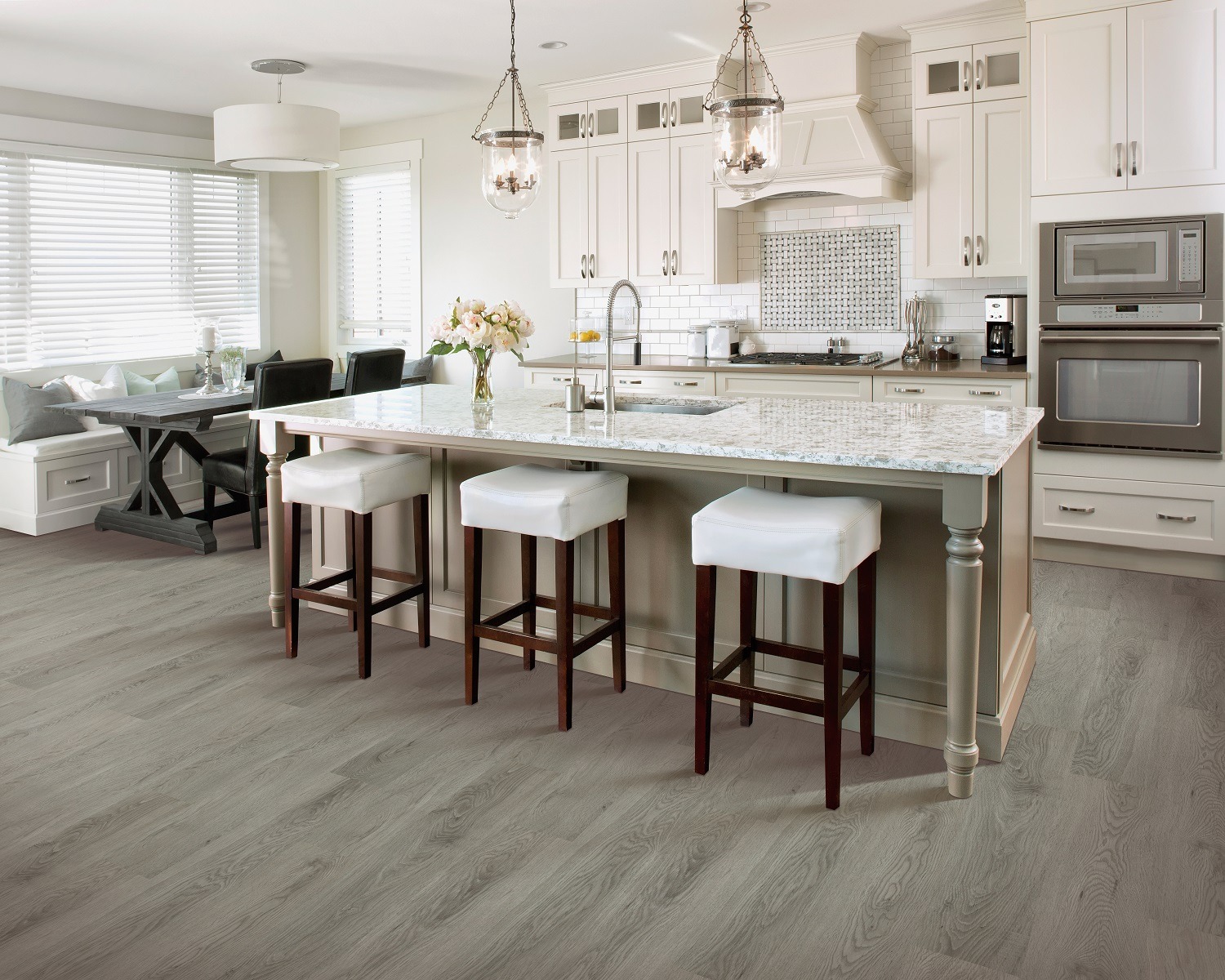
Introduction
Greetings, eager readers! Today, we embark on an extensive exploration of Luxury Vinyl Plank (LVP) flooring, a dynamic choice for both residential and commercial spaces. From the diverse types of LVP to the critical role of underlayment, durability, costs, finishes, and installation methods, this comprehensive guide aims to empower you with insights for your flooring endeavors.
Types of LVP Flooring
- Traditional LVP:
Traditional LVP exudes timeless charm, making it a perfect fit for residential settings. The warmth it brings, coupled with an array of wood species and colors, lends itself well to creating cozy home interiors. Residential Application: Traditional LVP seamlessly integrates into various home styles, enhancing living rooms, bedrooms, and even kitchens with its classic allure. Commercial Application: While less common, traditional LVP finds a place in offices or retail spaces, offering a touch of familiarity and comfort. - Stone-Look LVP:
The opulence of stone-look LVP makes it a statement piece in high-end residential spaces, bringing luxury underfoot. Residential Application: Ideal for upscale residences, stone-look LVP elevates living spaces, especially in entryways and formal areas. Commercial Application: Frequently chosen for high-end commercial establishments, it adds sophistication to corporate offices or boutique stores. - Wide-Plank LVP:
With its contemporary appeal, wide-plank LVP is a favorite among homeowners seeking a modern touch. Residential Application: Perfect for open floor plans, it enhances the sense of space in living areas and kitchens. Commercial Application: Embraced in modern office spaces, wide-plank LVP contributes to a sleek and trendy corporate aesthetic. - Distressed LVP:
Distressed LVP, with its weathered finishes, introduces character to both residential and commercial spaces. Residential Application: Ideal for homeowners desiring a rustic or vintage look, it adds a unique charm to living spaces. Commercial Application: Selectively used in commercial settings, distressed LVP can inject personality into retail spaces or themed establishments.
Types of Underlayment and Their Significance
Understanding underlayment is crucial, and the choice varies based on the unique demands of residential and commercial settings.
- Foam Underlayment:
Foam underlayment, lightweight and budget-friendly, finds favor in residential applications where moderate foot traffic is expected. Residential Application: Ideal for bedrooms and living rooms, providing a comfortable underfoot feel. Commercial Application: Rarely used in commercial spaces due to its limitations in handling heavy foot traffic. Installation Method: Floating installation is common for foam underlayment, allowing for flexibility and ease. - Rubber Underlayment:
Known for sound absorption, rubber underlayment suits both residential and commercial settings where noise reduction is crucial. Residential Application: Excellent for apartments or upper-level rooms, creating a quieter living environment. Commercial Application: Often used in offices or multi-tenant buildings to minimize sound transmission. Installation Method: Glue-down or floating installation methods work well with rubber underlayment, depending on the specific needs of the space. - Cork Underlayment:
Cork underlayment, with natural insulation and moisture resistance, serves a versatile role in both residential and commercial applications. Residential Application: Beneficial in areas prone to temperature fluctuations, such as basements or kitchens. Commercial Application: Suitable for spaces with varying temperatures, providing insulation and comfort underfoot. Installation Method: Cork underlayment often pairs well with floating installations, offering additional warmth and cushioning. - Combination Underlayment:
Blending materials for enhanced performance, combination underlayment addresses the demands of high-traffic areas in both residential and commercial spaces. Residential Application: Effective in busy areas like hallways or entryways where durability and sound reduction are essential. Commercial Application: Commonly used in spaces with heavy foot traffic, such as retail stores or hospitality venues. Installation Method: The installation method varies based on the combination of materials, with floating or glue-down being common options.
Durability, Cost & Installation
While the overall durability of LVP remains a universal factor, the wear and tear patterns differ between residential and commercial applications.
Residential Application: LVP stands strong against the demands of everyday life, offering a cost-effective and long-lasting flooring solution for homes.
Commercial Application: In commercial spaces, where foot traffic is more intense, opting for a thicker wear layer and high-quality construction becomes imperative for maximizing longevity.
Installation Method: Both residential and commercial spaces often utilize the floating installation method for its flexibility and ease of maintenance.
Average Costs: Cost considerations are crucial in both residential and commercial projects, with differences arising from varying specifications.
Residential Application: Homeowners enjoy a broad range of options, with average costs ranging from $2 to $7 per square foot.
Commercial Application: Commercial projects may incur higher costs due to the need for more durable options, thicker wear layers, and specialized designs.
Installation Method: Professional installation is common in both settings, ensuring precise and efficient placement.
Different Finishes
The finish of LVP significantly impacts aesthetics and performance, catering to the unique atmospheres of residential and commercial spaces.
- Matte Finish:
A matte finish, providing a natural and low-gloss appearance, suits various residential spaces. Residential Application: Ideal for areas with high foot traffic, matte finishes excel at concealing small scratches and imperfections. Commercial Application: Commonly used in commercial spaces with a relaxed atmosphere, such as offices or low-traffic retail areas. Installation Method: Floating or glue-down installations are suitable for matte-finished LVP. - Glossy Finish:
A glossy finish, offering a polished and reflective surface, adds sophistication to both residential and commercial spaces. Residential Application: Adds glamour to formal areas, reflecting light and creating a visually stunning effect. Commercial Application: Often chosen for upscale commercial settings, enhancing the overall aesthetic of spaces like high-end retail stores or corporate offices. Installation Method: Glue-down installations are commonly employed for glossy finishes. - Textured Finish:
Textured finishes, replicating the feel of natural wood or stone, contribute to the authenticity of LVP flooring. Residential Application: Popular in rustic or distressed styles, enhancing the overall aesthetic and appeal in residential spaces. Commercial Application: Selectively used in commercial settings to add character and personality, particularly in themed establishments or unique retail spaces. Installation Method: Floating or glue-down installations are suitable for textured-finish LVP.
Average Square Foot per Box
Accurate planning is essential in both residential and commercial applications, considering the specific coverage per box.
Residential Application: Homeowners can effectively plan projects with an average coverage of around 20 to 30 square feet per box.
Conclusion
Luxury Vinyl Plank (LVP) flooring, with its versatility, durability, and aesthetic appeal, seamlessly integrates into older residential homes, newer residential homes, and commercial spaces. From the choice of LVP types to the intricacies of underlayment, durability factors, costs, finishes, and installation methods, this comprehensive guide equips you to make informed decisions tailored to the unique demands of each setting. Whether you’re transforming your home or enhancing a commercial establishment, a well-chosen LVP floor ensures not only a visual delight but also a lasting investment in style and functionality.

